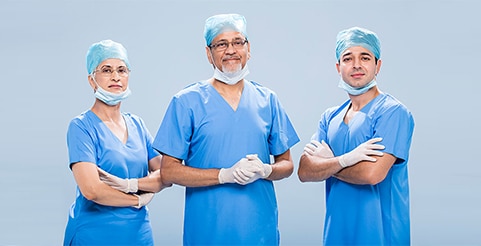Maxillofacial and Dental Surgery
What is maxillofacial surgery?
Maxillofacial surgery is a surgery that is done to correct diseases, injuries or defects to your face, jay or mouth by maxillofacial surgeon who are highly trained dental surgeons who are experts in identifying and treating problems with bones and tissues of your jaw and lower face (also known as maxillofacial area), root of your mouth (also know as palate) and your teeth.
Why is maxillofacial surgery done?
Maxillofacial surgery is primarily done to improve jaw function and relieve pain. There are several dental problems address by maxillofacial surgery and includes the following:
- Finding the underlying cause for chronic dental pain
- Preparing the mouth for putting dental implants and prostheses like dentures
- Extracting impacted teeth
- Treating oral diseases
There are several jaw problems address by maxillofacial surgery and includes the following
- Bone grafting – This is a procedure where bone is transplanted from another area of your body to the area that is missing in your jaw
- Treating temporomandibular joint (TMJ) disorders – These are disorders that affect the area where your lower jaw attaches to your skull
- Treating any injuries from trauma to your jaw, face and mouth
Maxillofacial surgery is also done in conditions like the following:
- Correcting cleft lip and palate which are congenital abnormalities present at birth
- Diagnosing and treating tumours, cancer, cysts and other benign growths in your head and neck.
- Treating facial fractures or damaged maxillofacial tissue resulting from injury due to facial trauma.
What happens during maxillofacial surgery?
When you visit a dentist or a primary care provider and they recognize that your condition needs a maxillofacial surgery, they will refer you to a maxillofacial surgeon. When you consult with a maxillofacial surgeon you will be asked about your symptoms, your medical history and any medications that you may be currently taking. Then the surgeon will examine your oral cavity and surrounding areas. They will order tests such as dental X-rays, 3D scans to get detailed images of the maxillofacial structures. This will help them diagnose the condition accurately and then recommend a treatment plan and corrective surgery.
What happens before maxillofacial surgery?
Depending on the problem the procedures vary. Some surgeries can be performed in an out-patient setting and post the surgery you can go home on the same day. Certain other conditions might warrant multiple surgeries done over a period of time to achieve the desired results. Anaesthesia is an important component of maxillofacial surgery and our surgeons are highly trained to handle different types of anaesthesia and will decide and discuss with you on what type of anaesthesia is best for you. Once the surgery is completed, they may have to use stitches to close the wound or may use packing in your mouth to protect your teeth or the wound and to absorb fluids such as blood and pus.
What happens after maxillofacial surgery?
Post the surgery, you will be moved to a recovery room. Once your anaesthesia wears out might experience some discomfort or pain. You may also experience bleeding, bruising, swelling and limited use of jaw and teeth. Your surgeon will discuss with you how the surgery went, do’s and don’ts during recovery, when you can go home and how to take care of yourself during recovery. If you receive anaesthesia, you should have someone drive you home.
What are the advantages of maxillofacial surgery?
Maxillofacial surgery can relieve chronic pain permanently, it can improve your jaw function and it can improve your appearance.
What are the risks or complications of maxillofacial surgery?
Risks from maxillofacial surgery includes:
- Infection
- Bleeding
- Dry socket
- Pain
- Root fragments
- Temporomandibular joint disorders
- Numbness or any changes in sensation in your mouth or other areas of your face due to possible damage to your facial muscles or nerves
- Injury to teeth, lips, tongue, cheeks, chin, nasal cavity, sinuses, or maxillofacial bones or tissue.
What’s recovery like after maxillofacial surgery?
Your stitches will either dissolve or will be removed in a week. You may experience discomfort such as sensitivity, swelling, bleeding that will last for a few days. You will be given pain medications to keep you comfortable. You will have to avoid certain foods and activities for a few days or weeks after surgery depending on the type of procedure you have had. You will be recommended to avoid sugary drinks, hot and cold drinks, avoid tobacco products, avoid exercising, avoid foods that are hard and chewy, prescribe a liquid diet, asked to rest, asked to rinse your teeth instead of brushing for a few days to kill bacteria in the mouth, etc
When should I call my healthcare provider?
Please call the hospital if you experience fever, chills, abnormal bleeding or swelling, chronic pain that does not get better gradually, have a salty or metallic or bad taste in the mouth that does not go away, develop pus in the mouth.


 In-person Consultation
In-person Consultation Online Video Consultation
Online Video Consultation Treatment Enquiries
Treatment Enquiries Find a Doctor
Find a Doctor Access the Patient Portal
Access the Patient Portal +91 44 4524 2407
+91 44 4524 2407  Minimal Access GI & Bariatric Surgery
Minimal Access GI & Bariatric Surgery Multi-Visceral and Abdominal Organ Transplant
Multi-Visceral and Abdominal Organ Transplant Neurology
Neurology Spine Surgery
Spine Surgery Total Knee replacement
Total Knee replacement Anaesthesiology & SICU
Anaesthesiology & SICU Paediatric Cardiology
Paediatric Cardiology Emergency Na MGM
Emergency Na MGM IVF
IVF Oncology Treatments
Oncology Treatments







